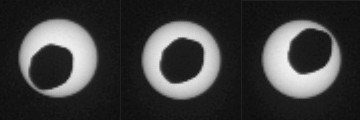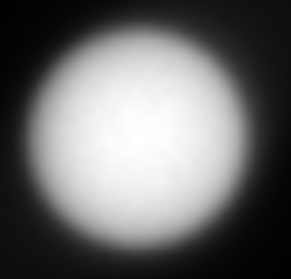Solar eclipses on Mars on:
[Wikipedia]
[Google]
[Amazon]
 The two moons of
The two moons of
 Due to the small size of Phobos (about ) and its rapid orbital motion, an observer on the surface of Mars would never experience a solar eclipse for longer than about thirty seconds. Phobos also takes only 7 hours 39 minutes to orbit Mars, while a Martian day is 24 hours 37 minutes long, meaning that Phobos can create two eclipses per Martian day. These are
Due to the small size of Phobos (about ) and its rapid orbital motion, an observer on the surface of Mars would never experience a solar eclipse for longer than about thirty seconds. Phobos also takes only 7 hours 39 minutes to orbit Mars, while a Martian day is 24 hours 37 minutes long, meaning that Phobos can create two eclipses per Martian day. These are
NASA’s Perseverance Rover Captures Video of Solar Eclipse on Mars
California Institute of Technology, April 20, 2022.
Eclipse of the Sun by Phobos
{{DEFAULTSORT:Solar Eclipses On Mars Solar eclipses by planet Mars Articles containing video clips
 The two moons of
The two moons of Mars
Mars is the fourth planet from the Sun. It is also known as the "Red Planet", because of its orange-red appearance. Mars is a desert-like rocky planet with a tenuous carbon dioxide () atmosphere. At the average surface level the atmosph ...
, Phobos and Deimos, are much smaller than Earth's Moon
The Moon is Earth's only natural satellite. It Orbit of the Moon, orbits around Earth at Lunar distance, an average distance of (; about 30 times Earth diameter, Earth's diameter). The Moon rotation, rotates, with a rotation period (lunar ...
, greatly reducing the frequency of solar eclipse
A solar eclipse occurs when the Moon passes between Earth and the Sun, thereby obscuring the view of the Sun from a small part of Earth, totally or partially. Such an alignment occurs approximately every six months, during the eclipse season i ...
s on that planet. Neither moon's apparent diameter
The angular diameter, angular size, apparent diameter, or apparent size is an angular separation (in units of angle) describing how large a sphere or circle appears from a given point of view. In the vision sciences, it is called the '' visual ...
is large enough to cover the disk of the Sun, and therefore they are annular solar eclipse
A solar eclipse occurs when the Moon passes between Earth and the Sun, thereby obscuring the view of the Sun from a small part of Earth, totally or partially. Such an alignment occurs approximately every six months, during the eclipse season i ...
s and can also be considered transits.
Eclipses caused by Phobos
 Due to the small size of Phobos (about ) and its rapid orbital motion, an observer on the surface of Mars would never experience a solar eclipse for longer than about thirty seconds. Phobos also takes only 7 hours 39 minutes to orbit Mars, while a Martian day is 24 hours 37 minutes long, meaning that Phobos can create two eclipses per Martian day. These are
Due to the small size of Phobos (about ) and its rapid orbital motion, an observer on the surface of Mars would never experience a solar eclipse for longer than about thirty seconds. Phobos also takes only 7 hours 39 minutes to orbit Mars, while a Martian day is 24 hours 37 minutes long, meaning that Phobos can create two eclipses per Martian day. These are annular eclipse
A solar eclipse occurs when the Moon passes between Earth and the Sun, thereby obscuring the view of the Sun from a small part of Earth, totally or partially. Such an alignment occurs approximately every six months, during the eclipse season i ...
s, because Phobos is not quite large enough or close enough to Mars to create a total solar eclipse. The highest resolution, highest frame rate video of a Phobos transit has been recently released from the Mastcam-Z on Perseverance rover.Jet Propulsion Laboratory--MarsNASA’s Perseverance Rover Captures Video of Solar Eclipse on Mars
California Institute of Technology, April 20, 2022.
Transits caused by Deimos
Deimos is too small (about ) and too far from Mars to cause an eclipse. The best an observer on Mars would see is a small spot crossing theSun
The Sun is the star at the centre of the Solar System. It is a massive, nearly perfect sphere of hot plasma, heated to incandescence by nuclear fusion reactions in its core, radiating the energy from its surface mainly as visible light a ...
's disc.
View from Mars
March 5, 2024: NASA released images of transits of the moon Deimos, the moon Phobos and the planet Mercury as viewed by the ''Perseverance'' rover on the planet Mars.View from Earth
Both moons are too small to cast a shadow on Mars that can be seen from Earth. However, shortly after the firstartificial satellite
A satellite or an artificial satellite is an object, typically a spacecraft, placed into orbit around a celestial body. They have a variety of uses, including communication relay, weather forecasting, navigation ( GPS), broadcasting, scienti ...
s were placed in orbit
In celestial mechanics, an orbit (also known as orbital revolution) is the curved trajectory of an object such as the trajectory of a planet around a star, or of a natural satellite around a planet, or of an artificial satellite around an ...
around Mars, the shadow of Phobos was seen in pictures transmitted to Earth.
One of these photos was from the NASA rover ''Opportunity''.
References
External links
Eclipse of the Sun by Phobos
{{DEFAULTSORT:Solar Eclipses On Mars Solar eclipses by planet Mars Articles containing video clips